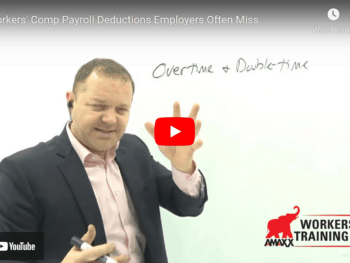Workers compensation insurance policies can be divided into three basic categories — Prospective (aka, Guaranteed Cost), Retrospective (Retro plan) and Cash Flow (Deductibles).
Defining the Plans
In a guaranteed cost plan, the premium is fixed prior to the start of the policy year and the only variable is payroll (subject to audit at the end of policy year).
In a retrospective insurance plan the final premium is based on the insured’s actual loss experience, with the contract providing for a minimum and maximum amount of premium.
In a deductible plan, the insured reimburses the insurer up to a set dollar amount and the insurer is responsible for all claim cost above the set dollar amount.
Most employers opt for a guaranteed cost insurance policy, but do not fully understand how their insurance premium is determined. From time to time we will hear the questions like “Why do we need to spend money on a safety program as we have a guaranteed cost insurance policy?” or “Why do we need to have a return to work program when we have a guaranteed cost insurance plan?”
Click Link to Access Free PDF Download
“Workers’ Comp Claims Review Checklist: 9 Must-Have, Serious-Impact Elements”
The simplest way to explain this would be to give a comparison to another type of insurance most people have – automobile liability insurance. Auto insurance is a guaranteed cost insurance policy. You know what the premium is at the start of the policy year. You do not know if you will have a claim against your policy or not, and if you do have a claim, you don’t know what the claim will cost. It could be a $1,000 or $100,000. However, you do know if you have a $100,000 claim the next year the car insurance premium will be at a guaranteed cost, but the dollar amount of the insurance policy will be much higher.
It works the same way with a guaranteed cost workers compensation insurance policy. If you have many workers comp claims, you can still get the guaranteed cost insurance policy but the claim history of your company will be evaluated prior to the premium being calculated for the new policy year. A high frequency of claims tells the underwriter at the workers comp insurer that your company has poor safety controls and lacks management oversight, just like several auto accidents tells the underwriter you are a bad driver.
A key concept to keep in mind with a guaranteed cost workers comp policy is the cost is guaranteed only for one year. A poor history guarantees the cost will be higher the following year.
Regardless of whether you have a guaranteed cost insurance plan, a retro plan or a deductible plan for your workers compensation insurance coverage, you need to have a complete cost containment strategy for your company.
9 Cost Containment Strategies to Reduce Cost of Workers Compensation
- Have a strong safety program with senior management emphasis to eliminate injuries before the occur. Constantly promote job safety and preventive measures. Be sure employees are properly trained to operate equipment or machinery, and know proper lifting techniques.
- Recognize the task(s) that create injuries on a regular basis and take the necessary steps to change the way the task(s) is/are done to remove the cause of injury from the task(s).
- Have an established return to work program providing modified duty or light duty work for your employees before the injury occurs. This allows you to get an injured employee back to work as soon as the treating doctor allows. Request the work restrictions from the medical provider at the time of the initial treatment.
- Have an established protocol of on-going communications with every injured worker until the worker is back on the job.
- Be a drug-free workplace with an active drug-testing program, including pre-employment, post accident and random drug testing.
- When the medical provider will not permit the employee to return to work on modified duty, have a nurse case manager assigned to the claim to provide medical management, which will have a positive impact on the medical cost.
- If your business operation is large enough, have an on-staff nurse or doctor treat workers comp injuries on-site. If not, consider nurse triage which occurs at the moment the injury occurs. The nurse determines the urgency of treatment and/or whether ER, clinic visit or self-care is appropriate.
- Have a pre-employment screening program.
- Have an active fraud prevention program including posters, anonymous tip line and check endorsement program.
Cost containment in a guaranteed cost insurance plan is no different that cost containment in any other type of insurance. The better your safety record and the fewer claims you have had, the lower the overall cost of your workers comp insurance. Any steps your company takes to minimize the number of claims you have and any steps your company takes to lower the cost of the claims that do occur, will have a positive impact on your guaranteed cost insurance policy.
Author Rebecca Shafer, JD, President of Amaxx Risks Solutions, Inc. is a national expert in the field of workers compensation. She is a writer, speaker and website publisher. Her expertise is working with employers to reduce workers compensation costs, and her clients include airlines, healthcare, printing/publishing, pharmaceuticals, retail, hospitality and manufacturing.
Contact: RShafer@ReduceYourWorkersComp.com or 860-553-6604.
FREE TOOLS
WORK COMP CALCULATOR: http://www.LowerWC.com/calculator.php
MODIFIED DUTY CALCULATOR: http://www.LowerWC.com/transitional-duty-cost-calculator.php
JOIN WC GROUP: http://www.linkedin.com/groups?homeNewMember=&gid=1922050/
Do not use this information without independent verification. All state laws vary. You should consult with your insurance broker or agent about workers comp issues.













